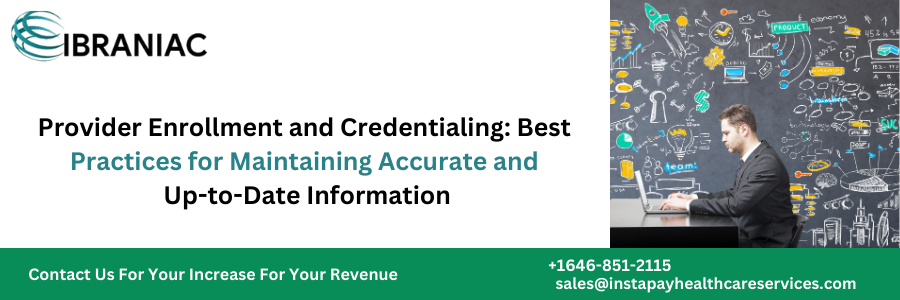
Provider Enrollment and Credentialing: Best Practices for Maintaining Accurate and Up-to-Date Informationg
by admin | April 15, 2024 | 0 comments,
1) Introduction
In the dynamic panorama of healthcare, accurate and up to date facts is essential for provider enrollment and credentialing methods. From making sure compliance with regulations to facilitating seamless patient care, retaining accurate facts is paramount. This complete manual delves into the satisfactory practices for achieving and maintaining accuracy in provider enrollment and credentialing.
2) Understanding Provider Enrollment and Credentialing :
Provider enrollment and credentialing involve verifying healthcare specialists' qualifications,licenses, and credentials to ensure they meet regulatory requirements and can supply secure and quality care to patients. It encompasses a series of steps, including application submission, primary supply verification, and ongoing monitoring.
3) The Significance of Accurate Information
Accurate facts bureaucracy the foundation of effective provider enrollment and credentialing. It minimizes the risk of errors, complements patient protection, and promotes believe among stakeholders. Moreover, it ensures compliance with accreditation standards and regulatory requirements, safeguarding in opposition to potential legal and financial repercussions.
4) Streamlining Data Collection Processes
Efficient records collection procedures are essential for acquiring accurate statistics from providers. Implementing electronic systems and standardized forms can streamline the gathering manner, lessen errors, and decorate facts integrity. Automation equipment, such as electronic verification structures, facilitate actual-time validation of credentials, expediting the enrollment procedure.
5)Establishing Comprehensive Verification Protocols
Establishing complete verification protocols is important for making sure the accuracy of provider records. Conducting number one source verification without delay with issuing authorities, along with licensing boards and educational establishments, validates the authenticity of credentials. Regular audits and reviews assist become aware of discrepancies and ensure ongoing compliance.
6) Leveraging Technology for Data Management
Technology plays a pivotal position in modernizing facts control practices for provider enrollment and credentialing. Utilizing strong credentialing software program centralizes statistics, improves accessibility, and enables well timed updates. Automated signals and reminders notify stakeholders of expiring credentials, enabling proactive renewal efforts.
7) Enhancing Collaboration and Communication
Effective collaboration and conversation between diverse stakeholders are crucial for maintaining accurate information. Establishing clean channels of verbal exchange among credentialing staff, providers, and regulatory corporations helps the alternate of statistics and ensures alignment with requirements.
8) Implementing Ongoing Monitoring Mechanisms
Ongoing tracking mechanisms are critical for preserving provider facts contemporary and compliant. Regularly reviewing provider credentials, licensures, and certifications enables spark off identity of changes or discrepancies. Utilizing monitoring tools and dashboards enhances visibility and permits proactive interventions.
9) Addressing Data Quality Challenges
Despite excellent efforts, healthcare companies may additionally encounter records best demanding situations in provider enrollment and credentialing. Addressing not unusual troubles consisting of incomplete or outdated records calls for proactive measures. Regular statistics audits, personnel education, and method enhancements contribute to enhancing data nice and accuracy.
10) Ensuring Regulatory Compliance
Regulatory compliance is a cornerstone of provider enrollment and credentialing approaches. Adhering to accreditation standards, nation policies, and federal requirements is imperative for fending off consequences and preserving licensure. Regularly updating guidelines and approaches to mirror regulatory adjustments promotes ongoing compliance.
11) Promoting Continuous Improvement
Continuous improvement is critical for optimizing provider enrollment and credentialing operations. Gathering comments from stakeholders, analysing overall performance metrics, and identifying regions for enhancement fosters a subculture of excellence. Implementing iterative upgrades guarantees that tactics remain green, adaptable, and aware of evolving needs.
FAQs (Frequently Asked Questions)
How often should provider credentials be verified?
Provider credentials have to be verified upon preliminary enrollment and regularly thereafter, normally each two years or as in keeping with organizational regulations.
What is primary source verification?
Primary supply verification involves directly contacting issuing authorities, along with licensing boards and educational establishments, to confirm the authenticity of provider credentials..
Why is ongoing monitoring important?
Ongoing monitoring guarantees that provider information remains correct and updated by way of promptly figuring out modifications or discrepancies in credentials, licensures, and certifications.
How can healthcare organizations address data quality challenges?
Healthcare groups can address statistics first-class demanding situations via normal audits, workforce education, procedure upgrades, and the implementation of sturdy records management structures.
What are the consequences of non-compliance with regulatory requirements?
Non-compliance with regulatory necessities can result in penalties, legal liabilities, and lack of licensure, jeopardizing the corporation's popularity and financial balance.
How can technology aid in data management for provider enrollment and credentialing?
Technology can useful resource in facts control by means of centralizing statistics, automating verification techniques, facilitating actual-time updates, and presenting indicators for expiring credentials.
Conclusion
Maintaining correct and updated data is important for effective provider enrollment and credentialing. By imposing excellent practices, leveraging technology, and fostering a tradition of continuous improvement, healthcare agencies can ensure compliance, enhance patient safety, and streamline operations.
Looking for expert assistance with your provider enrollment and credentialing needs? Look no further! Contact Instapay Healthcare Services today for efficient and affordable solutions tailored to your requirements. Whether you need assistance with data management, verification protocols, or ongoing monitoring, our experienced team is here to help.
Call us at + +1(646) 851-2115 or email us at sales@instapayhealthcareservices.com to learn more about how Instapay Healthcare Services can streamline your provider enrollment and credentialing processes. Don't let inaccuracies or compliance issues hold you back – trust Instapay Healthcare Services for reliable support and peace of mind.